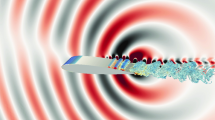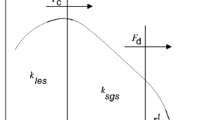Abstract
We propose a new formulation of the fourth-difference artificial dissipation coefficient needed for the Navier–Stokes solutions. This coefficient is scaled by a damping function which is expressed in terms of the Baldwin–Lomax algebraic turbulence model. The suggested scaling function damps the artificial dissipation across the boundary layer. The objective of this paper is to test the ability of the suggested damped scaling coefficient to provide (a) a given accuracy on a coarser grid; and (b) an accurate computing of turbulent boundary layers. To accomplish this, attached and separated transonic flows over the NACA 0012 airfoil, and turbulent flow over a flat plate have been considered.
Similar content being viewed by others
REFERENCES
Baldwin, B. S., and Lomax, H. (1972). Thin layer approximation and algebraic model for separated turbulent flows, AIAA Paper 78-257.
Caughey, D. A. (1988). Diagonal implicit multigrid algorithm for the Euler equations, AIAA J. 26, 841-851.
Hall, M. G. (1994). On the reduction of artificial viscosity in viscous flow solutions. In Caughey, D. A., and Hafez, M. M. (eds.), Frontiers of Computational Fluid Dynamics, John Wiley, pp. 303-317.
Holst, T. L. (1988). Viscous transonic airfoil workshop compendum of results, AIAA Paper 87-1640.
Jameson, A., Schmidt, W., and Turkel, E. (1981). Numerical solutions of the Euler equations by finite volume methods using Runge-Kutta time-stepping schemes, AIAA Paper 81-1259.
Martinelli, L. (1987). Calculations of viscous flows with multigrid methods, Ph.D. dissertation, Princeton University, MAE Department.
Reddy, S., and Papadakis, M. (1993). Artificial viscosity models for Navier-Stokes equations and their effect in drag prediction, AIAA Paper 93-0193.
Stock, H. W., and Haase, W. (1987). The determination of turbulent length scales in algebraic turbulence models for attached and slightly separated flows using Navier-Stokes methods, AIAA Paper 87-1302.
Swanson, R. C., and Turkel, E. (1992). On central difference and upwind schemes, J. Comput. Physics 101, 292-306.
Swanson, R. C., and Turkel, E. (1993). Aspects of a high-resolution scheme for the Navier-Stokes equations, AIAA Paper 93-3372.
Turkel, E. (1988). Improving the accuracy of central difference schemes, 11th Intl. Conf. Numerical Methods in Fluid Dynamics, Springer-Verlag, New York, Lecture Notes in Physics 323, 586-591.
Turkel, E., and Vatsa, V. N. (1994). Effect of artificial viscosity on three-dimensional flow solutions, AIAA J. 32, 39-45.
Varma, R. R., and Caughey, D. A. (1991). Diagonal implicit multigrid solution of compressible turbulent flows, AIAA Paper 91-1571.
White, F. M. (1974). Viscous Fluid Flow, McGraw-Hill, New York.
Yadlin, Y., and Caughey, D. A. (1990). Block multigrid implicit solution of the Euler equations of compressible fluid flow, AIAA J. 29, 712-719.
Yakhot, A., Shalman, E., Igra, O., and Yadlin, Y. (1996). An algebraic-Q 4 turbulence model for transonic airfoil flows, J. Sci. Comput. 11(2), 71-98.
Author information
Authors and Affiliations
Rights and permissions
About this article
Cite this article
Shalman, E., Yakhot, A., Shalman, S. et al. Attenuating Artificial Dissipation in the Computation of Navier–Stokes Turbulent Boundary Layers. Journal of Scientific Computing 13, 151–172 (1998). https://doi.org/10.1023/A:1023270026913
Issue Date:
DOI: https://doi.org/10.1023/A:1023270026913




